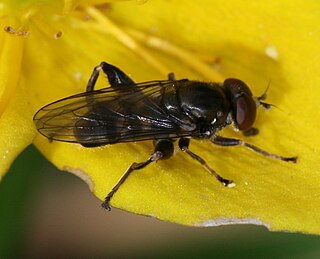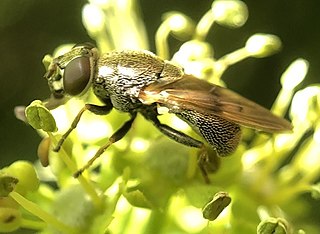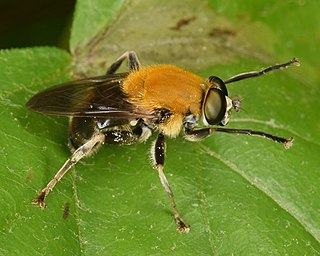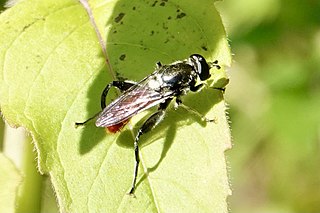
Temnostoma is a genus of hoverflies. The larvae of some species feed on the wood of deciduous trees.

Chalcosyrphus (Xylotomima) nemorum , the Dusky-banded Leafwalker, is a common species of syrphid fly with a Palearctic and Nearctic distribution. Hoverflies get their names from the ability to remain nearly motionless while in flight. The adults are also known as flower flies for they are commonly found around and on flowers, from which they get both energy-giving nectar and protein-rich pollen. Larvae have been found under the bark of Larix, Pinus and a variety of hardwoods.

The Brachyopini is a tribe of hoverflies. Unlike many members of this family these flies are generally darker and less colourful though some genera contain species with an attractive metallic lustre e.g. Chrysogaster. Some like Brachyopa are associated with sap runs where their larvae feed on decaying sap. Others are found in boggy areas where their often semiaquatic larvae feed on decaying organic matter.

Myolepta strigilata, the Scaled Pegleg, is an uncommon species of syrphid fly observed in the eastern and central United States. Hoverflies can remain nearly motionless in flight. The adults are also known as flower flies for they are commonly found on flowers, from which they get both energy-giving nectar and protein-rich pollen. The larvae of this genus have been found in rot holes of deciduous trees.

Spilomyia fusca, the Bald-faced Hornet Fly, is a fairly common species of syrphid fly first officially described by Loew, 1864 This species is found in North Eastern America. Hoverflies get their names from the ability to remain nearly motionless while in flight. The adults are also known as flower flies for they are commonly found around and on flowers from which they get both energy-giving nectar and protein-rich pollen. The larvae are known as the short-tailed larva tailored for moist areas such as rot holes of trees.

Spilomyia alcimus, the Broad-banded Hornet Fly, is an uncommon species of syrphid fly first officially described by Walker in 1849. Hoverflies get their names from the ability to remain nearly motionless while in flight. The adults are also known as flower flies for they are commonly found around and on flowers, from which they get both energy-giving nectar and protein-rich pollen. The larvae are known as the short-tailed larvae suited for moist areas such as rot holes of trees.

Brachypalpus oarus, the eastern catkin, is a common species of syrphid fly first officially described by Walker in 1849. Hoverflies get their names from the ability to remain nearly motionless while in flight. The adults are also known as flower flies for they are commonly found around and on flowers, from which they get both energy-giving nectar and protein-rich pollen. The larvae are of the rat-tailed type feeding on decaying sap under tree bark.

Pterallastes thoracicus , the Goldenback Fly, is an uncommon species of syrphid fly observed across central and eastern areas of the United States. Hoverflies can remain nearly motionless in flight while many are mimics of bees. The adults are also known as flower flies for they are commonly found on flowers, from which they get both energy-giving nectar and protein-rich pollen. The larvae are unknown.
Lejota aerea , the Golden Trunksitter , is an uncommon species of syrphid fly observed in eastern North America. Hoverflies can remain nearly motionless in flight. The adults are also known as flower flies for they are commonly found on flowers, from which they get both energy-giving nectar and protein-rich pollen. The larvae of this genus are found in decaying tree roots.
Xylota barbata is a species of hoverfly in the family Syrphidae.

Xylota bicolor ,, the Eastern Orange-tailed Leafwalker , is a rare species of syrphid fly observed across the eastern half of North America. Syrphid flies are also known as Hover Flies or Flower Flies because the adults are frequently found hovering around flowers from which they feed on nectar and pollen. Adults are 13.8–14.7 mm (0.54–0.58 in) in length, black with an orange abdomen The larvae of this genus live under bark in sap runs.
Sphegina lobata , the Yellow-lobed Pufftail, is an uncommon species of syrphid fly observed in northeastern North America. Hoverflies can remain nearly motionless in flight. The adults are also known as flower flies for they are commonly found on flowers, from which they get both energy-giving nectar and protein-rich pollen. Larvae found in accumulations of decaying sap under bark, usually in wet situations such as damp, shaded woodland and in partially submerged wood in streams and pools.

Sphegina rufiventris, the Black-horned Pufftail, is a common species of syrphid fly observed in the northeastern United States. Hoverflies can remain nearly motionless in flight. The adults are also known as flower flies for they are commonly found on flowers, from which they get both energy-giving nectar and protein-rich pollen. Larvae are found in accumulations of decaying sap under bark, usually in wet situations such as damp, shaded woodland and in partially submerged wood in streams and pools.

Parhelophilus integer , the shiny bog fly, is a rare species of syrphid fly observed in the Eastern United States. Hoverflies can remain nearly motionless in flight. The adults are also known as flower flies, for they are commonly found on flowers from which they get both energy-giving nectar and protein-rich pollen. The larvae of this genus are the long tailed "rat-tailed" type.
Parhelophilus divisus the yellow-legged bog fly, is a rare species of syrphid fly observed in the northeastern United States. Hoverflies can remain nearly motionless in flight. The adults are also known as flower flies for they are commonly found on flowers, from which they get both energy-giving nectar and protein rich pollen. The larvae are the long tailed "rat-tailed" type.
Cheilosia capillata, the scar-horned blacklet, is an uncommon species of syrphid fly observed in the northeastern United States. Hoverflies can remain nearly motionless in flight. The adults are also known as flower flies for they are commonly found on flowers, from which they get both energy-giving nectar and protein-rich pollen. Larvae when known are plant feeders.
Cheilosia comosa , the prairie blacklet, is a species of syrphid fly observed in across North America. Hoverflies can remain nearly motionless in flight. The adults are also known as flower flies for they are commonly found on flowers from which they get both energy-giving nectar and protein-rich pollen. Larvae when known are plant feeders.
Hiatomyia cyanescens, the cobalt deltawing, is an uncommon species of syrphid fly observed in the northeastern United States. Hoverflies can remain nearly motionless in flight. The adults are also known as flower flies for they are commonly found on flowers from which they get both energy-giving nectar and protein-rich pollen. The larvae are unknown.
Total of 245 species either found or highly expected to be found in New York.
Omegasyrphus coarctatus , the orange-legged ant fly, is a rare species of syrphid fly observed across the United States. Hoverflies can remain nearly motionless in flight. The adults are also known as flower flies for they are commonly found on flowers except Microdon species are seldom observed around flowers. Larvae have been found in the nests of the ant species Monomorium minutum and Aphaenogaster fulva











